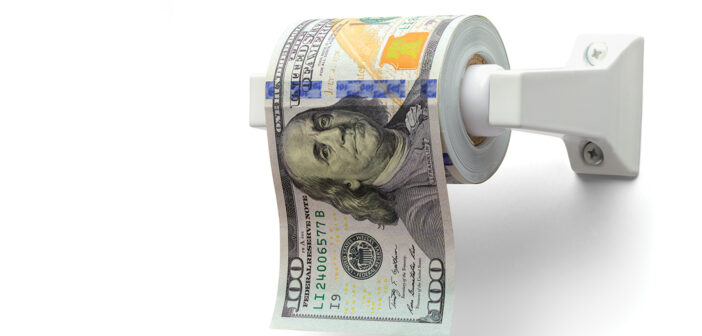In December, I wrote about the ratcheting-up of our inflationary numbers. We had recently heard from our Federal Reserve Chairman, Jerome Powell, that we need not worry because the inflation created through our government’s money printing policies and its COVID restriction-induced supply chain debacle was going to be “transitory.” I assumed that “transitory” must be related to something close to having an enema, because in my opinion, that’s exactly what this inflation situation has felt like. Much to my surprise after looking up the definition, the word transitory meant that this inflationary spike was going to be temporary. I then started reviewing some of the past Federal Reserve meeting minutes and realized that this transitory inflation has now lasted for over nine months! *
This all changed with the most recent “Fed Minutes.” It turns out that Chairman Powell is possibly removing the word “transitory” from future Fed reports. My interpretation of this move is that we could be in a new inflationary environment for some time to come. Most MCM readers will probably remember the 1980s and think, “Hey – we’ve been through tough inflationary times before.” That is true; but the inflation of the 2020s is nothing like the inflation of the ‘80s. In fact, I believe the current inflationary environment is much more dangerous and creating an even larger chasm between the ”haves” and the “have nots” in our society.
If you are old enough to remember the inflation of the ‘80s, then you likely remember the Golden Age of C.D. rates back then. For example: when inflation was at 10%, you might have been able to find a C.D. at the bank paying you 9% that you could lock in for two years.** At the same time, if you were lucky enough to be buying a home, you may have looked for a mortgage at 12% interest – a far cry from our current government-manipulated interest rates. In an effort to keep our economy stimulated and moving forward, our Fed think tanks have kept interest rates artificially low since the banking crisis of 2008. Keeping lending rates low encourages people to borrow money to invest in homes, businesses, rental properties and the like.
In financial circles, inflation has often been referred to as a tax on the poor. If you look closely, inflation has historically benefited the wealthy and people who own things tend to end up doing okay. In the past three years, if you owned a house or stocks, you’ve likely seen their value increase substantially. In fact, for the first time in the U.S., we’ve seen used cars appreciate in value! Unfortunately, lower-income American families are seeing surges in gasoline, rent and food prices, on which they spend a significant portion of their income. So while the rich get richer, the poor are getting poorer and the people who aren’t willing to risk their money outside of the FDIC insured banks are watching their spending power dwindle as inflation continues and bank rates stay close to zero.
In terms of interest rates, I believe that the Federal Reserve has been backed into a corner. To slow the pace of inflation, I believe they will have to move forward with some drastic rate increases and unfortunately, they are being forced to do so at a time when the economy is starting to teeter on a slowdown. Historically, this combination has led to a recession. I say this to MCM readers who are in the “haves” category: be ready for a possible pendulum swing that may not be in your direction.
*bloomberg.com/news/articles/2021-06-05/yellen-sees-recent-inflation-as-transitory-rather-than-permanent
**brookings.edu/blog/up-front/2018/07/25/measuring-inflation-whats-changed-over-the-past-20-years-what-hasnt/








